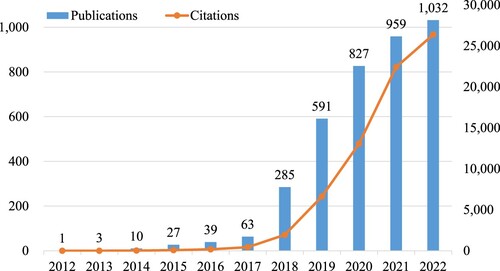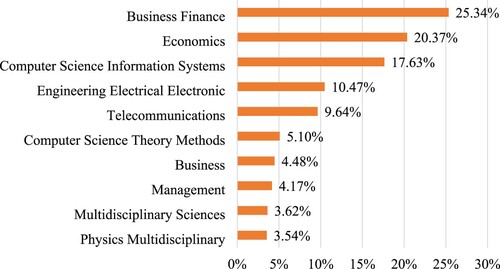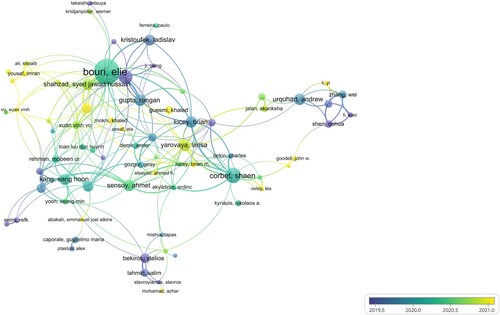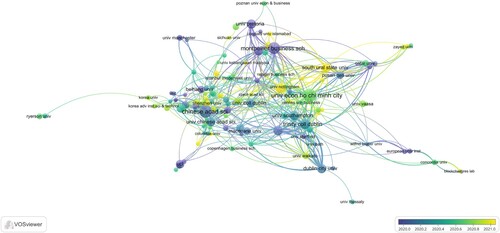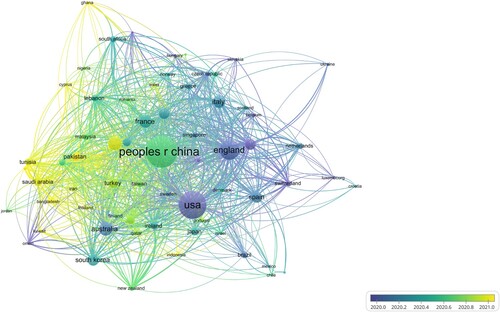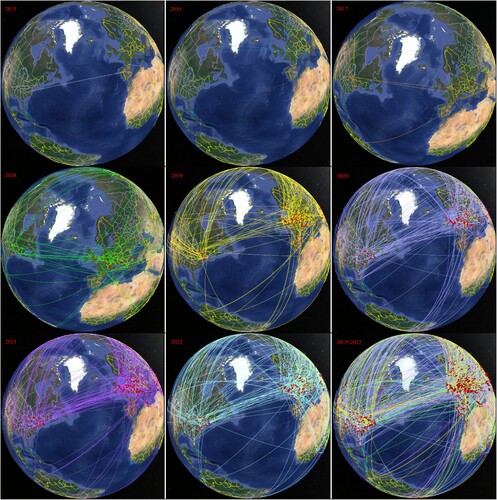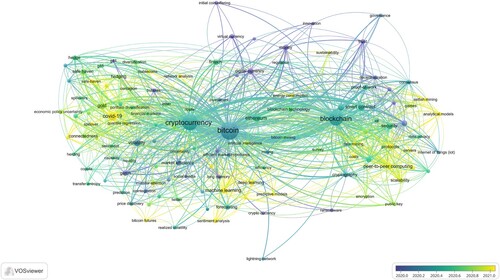 ?Mathematical formulae have been encoded as MathML and are displayed in this HTML version using MathJax in order to improve their display. Uncheck the box to turn MathJax off. This feature requires Javascript. Click on a formula to zoom.
?Mathematical formulae have been encoded as MathML and are displayed in this HTML version using MathJax in order to improve their display. Uncheck the box to turn MathJax off. This feature requires Javascript. Click on a formula to zoom.ABSTRACT
Bitcoin has been gaining increasing attention in academia and industry. This article investigates Bitcoin’s research status and evolution via bibliometrics using a dataset of 3,873 publications between 2012 and 2022 from the Web of Science Core Collection. The findings reveal a significant increase in research on Bitcoin since 2017, coinciding with the cryptocurrency bull market. The article identifies publication trends, influential contributors, collaboration networks, and topics evolution in Bitcoin research. The three Bitcoin research stages are conceptualisation and fundamentals of Bitcoin (2012–2016), cryptocurrency and market efficiency (2017–2018), and technical analysis, big data, data privacy, and the connection between Bitcoin and financial markets (2019–2022). The four prominent emerging areas for future Bitcoin research are decentralised finance (DeFi), non-fungible tokens (NFTs), clean energy and mining, and monetary policy. The article offers valuable insights for researchers, policymakers, and practitioners, facilitating a better understanding of the status quo of Bitcoin research.
1. Introduction
1.1. Background
Bitcoin, the world's first decentralised digital currency, is introduced by an anonymous individual or group using the pseudonym Satoshi Nakamoto (Citation2008). Bitcoin’s first block, or the Genesis Block, is mined on January 3, 2009. Bitcoin received limited attention during its early days, with only a few transactions. Over time, Bitcoin has gained increasing attention from researchers, individual investors, financial institutions, and policymakers, due to its disruptive potential. The interdisciplinary nature of Bitcoin has led to articles from diverse fields, e.g. computer science, business, management, economics, finance, law, and sociology, etc.
Bibliometrics is a quantitative approach that has been widely adopted to assess the development and dynamics in a research field. Bibliometrics assumes publications are indicative of intellectual contributions, and their citation patterns reflect the influence and interconnectedness of ideas within a given field. This means that bibliometrics does not problematise research phenomena as proposed by Alvesson and Sandberg (Citation2011), since assumptions are not challenged and biases are controlled for.
Following a bibliometric analysis approach, the authors formulated the following research questions (Alvesson and Sandberg Citation2011). Why is Bitcoin research relevant and interesting? What is the distribution pattern of publications and citations in Bitcoin research? What are the impactful countries/regions, institutions, researchers contributing to the Bitcoin research. What is the collaboration network in Bitcoin research? What are the influential publications and who are the influential authors in Bitcoin research? What are the growth patterns, interdisciplinary collaboration, and key thematic trends within the Bitcoin research landscape? How might the findings inform emerging topics and future research directions in the context of the rapidly evolving Bitcoin research? How does Bitcoin research interact with finance research more generally?
1.2. Contribution
The article contributes to the literature by conducting a comprehensive bibliometric analysis of 3,837 publications within the global research landscape on Bitcoin research. This article’s generalizability reflects these 3,837 publications’ breadth, depth and scope. The article’s theorisation and problematization are as follows: Participants of Bitcoin, i.e. researchers, individual Bitcoin holders, financial institutions, and regulators can through this article get a visualised overview of Bitcoin research. First, the article is beneficial for researchers to better understand the evolution and status quo of Bitcoin research and provide insights into the trajectory of choosing valuable research topics. Second, the article illustrates the evolution of Bitcoin publications, the distribution of disciplines and journals, the top cited articles, and the most prolific authors, institutions, and countries. Third, the article presents the Bitcoin research collaboration networks among authors, institutions, and countries/regions through co-authorship analysis. Their geographical distribution. The analysis can serve as a foundation for future research collaborations and knowledge exchange in the field of Bitcoin. Fourth, by analysing the keywords co-occurrence in Bitcoin research, the article identifies under-researched areas and potential avenues for future research, e.g. decentralised finance, non-fungible tokens, clean energy, and monetary policy. Overall, the article provides a comprehensive overview of the global research landscape on Bitcoin, thus contextualising Bitcoin research. It provides insights into the evolution, trend patterns, and future research efforts of Bitcoin research.
2. Literature
The literature commonly explores the economic and financial aspects of Bitcoin, including Bitcoin price dynamics (Wang and Hausken Citation2022a), the competition between fixed-supply like Bitcoin and variable-supply currency like central bank digital currency (Wang and Hausken Citation2022b, Citation2022c), governmental taxation involves Bitcoin and national currency (Wang and Hausken Citation2021b), market efficiency (Kurihara and Fukushima Citation2017; Urquhart Citation2016), and volatility and return (Dyhrberg Citation2016a; Katsiampa Citation2017). Researchers investigated the relationship between Bitcoin and traditional financial markets (Matkovskyy and Jalan Citation2019; Matkovskyy, Jalan, and Dowling Citation2020), the role of Bitcoin as an alternative investment asset (Al Mamun et al. Citation2020; Paule-Vianez, Prado-Román, and Gómez-Martínez Citation2020), and investment method (Mikhaylov Citation2020; Wang and Hausken Citation2023a). Furthermore, research has explored the potential of Bitcoin for international trade (Ganne Citation2018), and financial inclusion (Mavilia and Pisani Citation2020), and illegal activities like money laundering (Van Wegberg, Oerlemans, and Van Deventer Citation2018), and regulatory challenges associated with Bitcoin adoption (Cumming, Johan, and Pant Citation2019), and blockchain technology adoption in developed relative to developing countries (Bhimani, Hausken, and Arif Citation2021), monetary policy implications (Schilling and Uhlig Citation2019).
Wang et al. (Citation2021) apply bibliometric analysis to examine blockchain-related research. They identify the evolution of blockchain research and propose emerging topics for future research. Yu, Yin, and Wang (Citation2023) investigate the status quo and dynamic of quantitative finance research using a dataset of 2,723 publications. Merediz-Solà and Bariviera (Citation2019) conduct a bibliometric analysis of Bitcoin based on 1,162 articles during 2012–2019.
There are ongoing debates on review research. For example, Kunisch et al. (Citation2023) introduces review research as a distinct category of research inquiries that leverages prior research as data sources to generate knowledge contributions for academia, practice, and policy. They emphasise the significance of aligning the purpose and methods in various forms of review research for ensuring high quality. Antons et al. (Citation2023) emphasise the need for systematic and rigorous literature reviews while recognising the limitations of human researchers’ processing capabilities. They introduce and define computational literature reviews (CLRs) as a novel approach for conducting review research. This article contributes to the literature by conducting a comprehensive bibliometric analysis to provide insights into the Bitcoin research.
3. Data and methodology
Humankind deserves Bitcoin research, and finance research more generally, to create sound foundations for a healthy financial system. The extensive publications on Bitcoin research deserve a systematic analysis to present the status quo of the Bitcoin research and find directions for future research. For this purpose, we first proceed with data collection.
3.1. Data collection
This article employs the Web of Science Core Collection (WoS) to retrieve publication records. This article adopts a topic search (TS), i.e. the query formula TS = ‘Bitcoin’ is applied in the WoS, where TS covers title, abstract, author keywords, and keyword plus. A broad search query is preferable in bibliometric analysis for two reasons. First, it encompasses potentially relevant publications that may challenge or expand the existing knowledge on the topic. Second, irrelevant topics can be reduced or removed in bibliometric analysis using CiteSpace. The following steps are taken to refine the dataset. First, the publication date range is set from January 1, 2,008 to December 31, 2022. Second, the document type is limited to article, early access, and proceeding paper. Third, the duplicate removal function in CiteSpace is applied to eliminate duplications. Finally, a dataset of 3,837 publications about Bitcoin (downloaded on February 15, 2023) is collected.
3.2 . Methodology
The article begins with a statistical analysis to explore the dataset. Statistical analysis provides an overview of constituents, e.g. authors, institutions, countries, and their contributions within a research field. Thereafter, the article proceeds with bibliometric analysis, which focuses on the relationships and connections among research elements, e.g. authors, institutions, countries, topics.
Alternatives to bibliometric analysis are altmetrics, expert opinions, patent analysis, meta-analysis, text mining, machine learning, and artificial intelligence analysis, computational literature reviews, and various quantitative analysis and usage statistics. This article focuses on bibliometric analysis because of its common use and authors believe its explanatory power. Undertaking a systematic literature review on an individual basis for such a vast dataset would be practically unfeasible. Bibliometrics helps to examine the evolution, trends, and interdisciplinary collaborations within the vast and rapidly evolving Bitcoin field. The choice aligns with the article's objective of providing a comprehensive overview, as bibliometric analysis enables the assessment of publication patterns, citation networks, and thematic trends on a global scale. The article applies a bibliometric analysis approach due to its inherent capacity to systematically map and analyse tons of publications in the Bitcoin research filed.
4. Descriptive analysis
4.1. Overall growth
The dataset contains 3,837 publications, which are distributed in 1,024 journals. 8,390 authors from 7,503 institutions contribute to the publications in Bitcoin. The Bitcoin white paper, i.e. Bitcoin: A peer-to-peer electronic cash system was written by Nakamoto (Citation2008). Notably, the WoS does not include the Bitcoin white paper. The Bitcoin publications increase steadily during 2013–2017 and explode during 2017–2019, with publications increasing from 63 to 591. The trend continues after 2019 and reaches 1,032 publications in 2022. Correspondingly, the citations of Bitcoin-related publications have a similar patten. The Bitcoin publications’ citation increases from 435 in 2017 to 26,381 in 2022. The consistent upward trajectory of Bitcoin publications and citations demonstrates that academic interest in Bitcoin is exploding ().
4.2. Discipline categories
Bitcoin has garnered interest from various fields of research. In , most Bitcoin publications come from Business Finance, Economics, Computer Science Information Systems, Engineering Electrical Electronic, and Telecommunications. These areas have produced 973, 782, 677, 402, and 370 publications, representing percentages of 25.34%, 20.37%, 17.63%, 10.74%, and 9.64%, respectively. This is consistent with the nature of Bitcoin, which involves concepts such as peer-to-peer networks, cryptography, mining, proof of work, economics, and currency, etc. Additionally, researchers in other areas, e.g. Computer Science Theory Methods, Business, Management, and Multidisciplinary Sciences, have also been exploring Bitcoin. The wider range of research fields indicates the expanding impacts of Bitcoin.
4.3. Productive journals
lists the top 10 journals ranked by publications in the dataset. The total link strength indicates how strong the links are between a constituent, e.g. author, institution, country, and journal, with other constituents (Van Eck and Waltman Citation2013). Finance Research Letters ranks first with 222 publications and 9,772 citations. It has the highest total link strength, i.e. 6,348. Thereafter comes IEEE Access with 177 publications and 3,117 citations. Its total link strength is relatively low at 741. The third journal is Journal of Risk and Financial Management, with 79 publications and 706 citations. Notably, Economics Letters, International Review of Financial Analysis rank second and third in the total link strength, i.e. 3,845 and 2,697, respectively. Overall, most journals in the list pertain to economics and finance, exceptions, i.e. Physica A-Statistical Mechanics and Its Applications, IEEE Access.
Table 1. The top 10 journals ranked by publications in Bitcoin.
4.4. Highly cited articles
shows the top 10 cited articles in the dataset. The article by Tschorsch and Scheuermann (Citation2016) has the highest citations. They examine the Bitcoin protocol and its impact on digital currencies field while highlighting key concepts and structures. Thereafter comes the article by Dyhrberg (Citation2016a) that explores the financial asset features of Bitcoin. The article suggests that Bitcoin falls somewhere between gold and the US dollar in terms of classification. The third article by Böhme et al. (Citation2015) explores the benefits and challenges of Bitcoin and highlights its potential impact on traditional financial system. The other top 10 articles mainly explore Bitcoin market behaviour, speculation, and price volatility, and compare it with other financial assets.
Table 2. Top 10 cited articles in Bitcoin research based on the dataset.
5. Collaboration network analysis
5.1. Authors
5.1.1. Productive authors
presents the top 10 authors ranked by publications in the dataset. The most productive authors are Bouri, Elie, Corbet, Shaen, and Roubaud, David, with publications 67, 33, and 28, respectively. Other productive authors include Yarovaya, Larisa, Lucey, Brian, Sensoy, Ahmet, Shahzad, Syed Jawad Hussain, Gupta, Rangan, and Urquhart, Andrew.
Table 3. The top 10 authors ranked by publications in Bitcoin.
5.1.2. Co-authorship network
shows the co-collaboration network with a minimal of five articles in Bitcoin. Bouri, Elie, Roubaud, David, Gupta, Rangan collaborate closely. Authors, i.e. Corbet, Shaen, Shahzad, Syed Jawad Hussain, Sensoy, Ahmet and Naeem, Muhammad Abubakr, also have their good collaboration networks. Bouri Elie's strong collaborations with other researchers contribute to his research output, visibility, and impact.
5.2. Institutions
5.2.1. Productive institutions
presents the top 15 institutions ranked by publications in the dataset. The three most productive institutions are the University of Economics Ho Chi Minh City, the Chinese Academy of Sciences and Montpellier Business School. They have published 56, 52 and 48 papers, respectively, with citation counts of 1,968, 1,965 and 4,546. Univ Econ Ho Chi Minh City also has the highest total link strength, followed by Trinity Coll Dublin and Montpellier Business Sch. Notably, University of Economics Ho Chi Minh City takes the lead.
Table 4. The top 15 institutions ranked by publications in Bitcoin.
5.2.2. Network of co-author’s institutions
shows the collaboration network of institutions represented by co-authorships’ institutions (with a minimal of ten articles). Productive institutions usually have good collaboration networks.
5.3. Countries
5.3.1. Productive countries
shows the top 15 countries by publications in the dataset. The three most productive countries are China, USA and England, with 760, 624, 392 publications, 12,589, 15,533, 14,090 citations, respectively. China has most publications, while the citations per publication are relatively low at 16.6, compared to the USA’s 24.9 and England’s 35.9. The result suggests that both developed and developing countries are actively researching Bitcoin.
Table 5. The top 15 countries and regions ranked by publications in Bitcoin.
5.3.2. Network of co-authors’ countries/regions
depicts the collaboration network among the countries/regions represented by co-authorships’ countries and regions (with a minimal of ten articles). International collaboration in Bitcoin research is prevalent. The USA is the most influential country by citations and engages in active collaborations with England, Australia, Canada, and China. England exhibits a high frequency of cooperation with Germany, Italy, and Spain, three prominent countries in the network. Notably, The US, England, Gemeny, and Australia are identified as pioneers in exploring the field of Bitcoin. Asian countries, e.g. China, India, Pakistan, and Saudi Arabia, started to investigate Bitcoin began exploring Bitcoin comparatively later than these early adopters.
5.4. Analysis of global Bitcoin research collaboration: Google Earth Visualisation
depicts the evolution of the global Bitcoin research collaboration network from 2015 to 2022. It initially begins in the US and European countries like UK, Spain, France, etc. in 2015. It extends to Austria in 2016 and further expands to Asian countries like China, South Korea, India, etc. in 2018, when the global Bitcoin research collaboration network gains strength.
6. Science mapping analysis
6.1. Co-citation analysis
6.1.1. Cluster analysis of co-cited articles
Co-citation analysis is used to identify relationships and similarities between articles based on their co-citation patterns. Cluster analysis helps to identify research themes or topics. The article applies lag-likelihood ratio (LLR) method to obtain the cluster labels from keywords (Chen Citation2006). shows the result of cluster analysis for the co-citation network in the Bitcoin research.
summarises the co-cited articles in Bitcoin research. Silhouette indicates cluster homogeneity and Mean (Year) represents the average publication year in each cluster. The top 13 clusters with more than 20 publications are: Blockchain, market efficiency, bitcoin, connectedness, deep learning, Covid-19, privacy, GARCH (Generalised Autoregressive Conditional Heteroskedasticity), economic policy uncertainty, energy consumption, stakeholders, economic regulation, herding, and money. The publication years vary across clusters, with most falling between 2012 and 2017.
Table 6. Summary of co-cited articles in Bitcoin research.
6.1.2. Landmark nodes and pivot nodes
Landmark nodes are highly cited in a co-citation network. Pivot nodes have high betweenness centrality scores and function as central linking points within a co-citation network. summarises the details of landmark nodes and pivot nodes in the co-citation network of Bitcoin research. The major 10 landmark nodes are Eyal and Sirer (Citation2014), Tschorsch and Scheuermann (Citation2016), Bariviera et al. (Citation2017), Bariviera (Citation2017), Dyhrberg (Citation2016b), Urquhart (Citation2016), Ji et al. (Citation2019), Urquhart (Citation2018), Guesmi et al. (Citation2019), and Reid and Harrigan (Citation2011). Notably, Eyal and Sirer (Citation2014) is also a pivotal node that proposes modifications to Bitcoin mining protocol. Selgin (Citation2015) introduces the concept of synthetic commodity money, which combines features of both commodity and fiat money. Bouoiyour, Selmi, and Tiwari (Citation2015) analyse Granger causality between Bitcoin price, trade transactions, and investors’ attractiveness, confirming Bitcoin’s speculative nature but recognising its economic utility.
Table 7. Landmark nodes and pivot nodes in Bitcoin research.
6.1.3. Network of author co-citation
presents the top 10 most cited authors ranked by citations (the total citation within the dataset). Nakamoto (Citation2008) creates Bitcoin. Elie Bouri is well recognised for the empirical work on Bitcoin hedge and volatility (Balcilar et al. Citation2017; Bouri et al. Citation2017). Shaen Corbet contributes to the understanding of the connections between cryptocurrencies and other financial assets (Corbet et al. Citation2018; Corbet et al. Citation2019). Dirk Baur primarily focuses on the speculative features of Bitcoin (Baur, Hong, and Lee Citation2018).
Table 8. The top ten most cited authors in Bitcoin research based on the dataset.
6.2. Topic trends in Bitcoin research
6.2.1. Keyword co-occurrence analysis
shows the keyword co-occurrence network in Bitcoin research using the dataset, with a minimal of 15 co-occurrences. The top ten keywords with highest co-occurrence are Bitcoin, cryptocurrency, blockchain, Covid-19, Ethereum, smart contract, volatility, security, gold, and distributed ledger. Bitcoin, cryptocurrency, and blockchain are three fundamental concepts in the network. Other main topics are peer-to-peer computing, machine learning, digital currency, safe haven, privacy, Fintech, market efficiency, GARCH, money, and proof-of-work.
6.2.2. Bursts analysis of keyword co-occurrence
shows the keywords with the highest citation bursts in Bitcoin research. The evolution of the Bitcoin research field can be divided into three stages. The first stage (2012-2016) revolves around the conceptualisation and fundamentals of Bitcoin, with keywords such as digital currency and electronic money dominating the research landscape. The second stage (2017-2018) witnesses the expansion of research focus to encompass cryptocurrency and market efficiency, as reflected by the emerging keywords like Bitcoin market, cryptocurrency market and market efficiency. The third stage (2019-2022) witnesses a shift towards technical analysis, big data, data privacy, and the connection between Bitcoin and financial markets, as evidenced by keywords such as technical analysis, big data, and data privacy. These three stages may be compared against Bitcoin maximalists (e.g. Mark Yusko), who commonly cite Gandhi (Citation2023) as follows: First they ignore you 2009-2015, then they laugh at you 2015-2019, then they fight you 2019-2027, then you win 2027-.
Table 9. Keywords with the strongest citation bursts in Bitcoin research.
6.2.3. Time-zone view of keyword co-occurrence
shows the evolution of keyword co-occurrence in Bitcoin research. The primary early keywords are digital currency, internet of things, Bitcoin mining, and electronic. In 2017, with the rise of the cryptocurrency bull market, the main keywords are safe haven, cryptocurrency market, and cloud computing. Keywords such as smart contract, distributed ledger, market efficiency, blockchain technology, data mining, and artificial intelligence show up in 2018. In 2019, the focus expands to-peer-to-peer computing, machine learning, deep learning, portfolio diversification, and energy consumption. More recently, hot keywords are cryptocurrency market, stock market, network analysis, prediction models, price prediction, and reinforcement learning. Decentralised finance, non-fungible tokens, clean energy and mining, and monetary policy.
7. Future research, limitations and how society may benefit
The article identifies four prominent emerging areas for future Bitcoin research: Decentralised finance (DeFi), non-fungible tokens (NFTs), clean energy and mining, and monetary policy. First, the emergency of decentralised exchanges, lending protocols, stablecoins, and the impact of DeFi on financial system. Second, the NFTs’ role in digital ownerships, marketing implications, integration with the Bitcoin blockchain, dynamics of NFT markets. Third, the environmental impact of Bitcoin mining, the clean energy solutions and strategies to mitigate the carbon footprint. Fourth, the impacts of Bitcoin on monetary policies, central banking systems, and currencies competition.
The authors suggest interdisciplinary collaboration between the Bitcoin field and fields such as economics, finance, computer science, energy, management, and environmental studies, and practically any fields. As Bitcoin evolves, with ebbs and flows, within global finance, one new area for exploration is ethics associated with Bitcoin, including issues related to privacy, security, financial inclusion, and illegal activities. Another area of exploration pertains to the regulation challenges. This includes assessing the legal and jurisdictional challenges associated with Bitcoin transactions, and potential strategies for balancing innovation with regulatory compliance. Moreover, the societal implications of Bitcoin, investigating its impact on, for example, financial inclusion, economic stability, investment and wealth distribution. Future endeavours may explore how Bitcoin intersects with broader societal trends, e.g. democracy, organisation and management, innovation, etc.
No classification exists for actors which we consider to be a limitation of bibliometric analysis. We would prefer to classify the literature according to who benefit and do not benefit from the various kinds of Bitcoin research, how Bitcoin research benefits groups potentially differentially, for whom Bitcoin research is important, which actors and groups are potentially overrepresented versus underrepresented or not represented in Bitcoin research, etc. Some literature explores different actors in economies involving Bitcoin. For example, Wang and Hausken (Citation2023b) show that a borrower and buyer, a seller and multiple non-traders benefit differently from the availability of hard and fiat money. Wang and Hausken (Citation2021a) show that conventionalists, pioneers and criminals evolve[open-strick]s[close-strick] in different fractions in a system with a global currency such as Bitcoin approximated as hard money and a national fiat currency such as a central bank digital currency. Future research could assess how different societal actors such as individual users, developers, firms, commercial banks, central banks, regulators, governments and the broader society benefit or do not benefit differentially from changes in the financial system with and without Bitcoin. Future research can also delve into a more meticulous review of the existing Bitcoin publications. By connecting the dots between what has been studied and what remains unexplored, researchers can identify the significance of specific topics and ascertain their relevance to academia, systems, societies, and various stakeholders.
One limitation is that the article is based on a dataset of 3,837 articles. Future research may expand the data sources by combining articles from Scopus, and patent databases. Additionally, examining strategies of renowned Bitcoin institutional investors like MicroStrategy Inc.. Second, an intrinsic limitation is bibliometrics fails to capture the latest research in Bitcoin, as new articles are in the pipeline and may take time to gain attention in the academic field. Future research could explore alternative approaches to investigate the most recent publications in Bitcoin. Third, bibliometrics may not capture the full complexity of scientific research. Future research may consider combining other techniques, such as meta-analysis, case studies, content analysis, to better explore the Bitcoin research landscape and gain a deeper understanding of the field.
8. Conclusion
This article presents a comprehensive bibliometric analysis of Bitcoin research, utilising a dataset of 3,837 articles retrieved from the Web of Science Core Collection. The analysis encompasses multiple dimensions of Bitcoin research dynamics, including the overall growth of publications and citations, discipline categories, productive journals, distribution patterns, and identification of highly cited articles. The article identifies the most prolific contributors in the field of Bitcoin research, including authors, institutions, and countries/regions, and elucidates their collaboration networks through co-authorship analysis.
The main findings of this study are as follows. First, there has been a significant increase in Bitcoin publications since 2017, indicating that Bitcoin research has emerged as a hot topic. The most productive journals in Bitcoin pertain to economics and finance. Second, the most productive authors in this field are Bouri, Elie; Corbet, Shaen; and Roubaud, David. The most productive institutions contributing to Bitcoin research are the University of Economics Ho Chi Minh City, the Chinese Academy of Sciences, and Montpellier Business School. The most productive countries are China, US and UK.
Third, the global Bitcoin research collaboration network originated in the US and several European countries such as the UK, Spain, and France in 2015. The global Bitcoin research collaboration network has gained strength since 2018. Fourth, the top four clusters of co-cited articles with more than 100 articles in Bitcoin research are blockchain, market efficiency, bitcoin, and connectedness. The authors with the most citations are Satoshi Nakamoto, Elie Bouri, Shaen Corbet, Dirk Baur, and Anne Haubo Dyhrberg.
This article delineates Bitcoin research into three stages, i.e. conceptualisation and fundamentals of Bitcoin (2012-2016), cryptocurrency and market efficiency (2017-2018), and technical analysis, big data, data privacy, and the connection between Bitcoin and financial markets (2019-2022).
The findings of this bibliometric analysis offer valuable insights for researchers, policymakers, and practitioners in the field of Bitcoin. The article contributes both theoretically and practically to the Bitcoin field. Theoretically, the article contributes by offering a comprehensive understanding of the evolving global landscape of Bitcoin research through a rigorous bibliometric analysis. It identifies growth patterns, interdisciplinary collaborations, and key thematic trends, emerging research topics, providing valuable insights for scholars in the field. The article contributes to a deeper understanding of the evolving dynamics within Bitcoin research. Practically, the findings serve as a valuable resource for researchers, policymakers, and industry professionals, offering insights that can inform future research directions and potential applications in the rapidly evolving realm of Bitcoin.
Disclosure statement
No potential conflict of interest was reported by the author(s).
Data availability statement
Data associated with this article is straightforwardly downloadable from the Web of Science.
Additional information
Notes on contributors
Guizhou Wang
Guizhou Wang is a PhD candidate at the University of Stavanger, Norway, since 2020-06. He has published 25 articles in peer reviewed journals. His research fields are digital currencies, game theory, risk analysis, cryptocurrencies, central bank digital currencies, and econometrics. He holds a MSc degree in financial economics from the University of Chinese Academy of Sciences (Beijing, China), 2016-09–2019-06, focusing on mathematical finance, econometrics, venture capital, and cryptocurrency. He holds a BSc degree in finance from the Jinan University (Guangzhou, China), 2010-09–2014-06, focusing on finance, derivatives, and mathematical modelling. Email: [email protected].
Kjell Hausken
Kjell Hausken is a professor of economics and societal safety at the University of Stavanger, Norway, since 1999. His research fields are terrorism, societal safety, economics, economic risk management, economics and safety, political economy, information security, public choice, conflict, game theory, reliability, war, crime, risk analysis, disaster prevention, stochastic theory, dynamics, petroleum economics, resilience management. He holds a PhD from the University of Chicago (1990–1994), was a postdoc at the Max Planck Institute for the Studies of Societies (Cologne) 1995–1998, and a visiting scholar at Yale School of Management 1989–1990. He holds a Doctorate Program Degree (HAE) (‘Philosophical, Behavioural, and Gametheoretic Negotiation Theory’) in Administration from the Norwegian School of Economics and Business Administration (NHH), a MSc degree in electrical engineering, cybernetics, from the Norwegian Institute of Technology (NTNU), focusing on mathematics and statistics, and a minor in Public Law from the University of Oslo. He has published 280 articles in peer reviewed journals, one book, edited two books, is/was on the Editorial Board for Theory and Decision (May 20, 2007), Reliability Engineering & System Safety (January 17, 2012), and Defence and Peace Economics (December 4, 2007–December 31, 2015), has refereed 400 submissions for 85 journals, and advises and has advised seven PhD students. Email: [email protected].
References
- Al Mamun, M., G. S. Uddin, M. T. Suleman, and S. H. Kang. 2020. “Geopolitical Risk, Uncertainty and Bitcoin Investment.” Physica A: Statistical Mechanics and its Applications 540: 123107.
- Alvesson, M., and J. Sandberg. 2011. “Generating Research Questions through Problematization.” Academy of Management Review 36 (2): 247–271.
- Antons, D., C. F. Breidbach, A. M. Joshi, and T. O. Salge. 2023. “Computational Literature Reviews: Method, Algorithms, and Roadmap.” Organizational Research Methods 26 (1): 107–138.
- Baker, S. R., N. Bloom, and S. J. Davis. 2016. “Measuring Economic Policy Uncertainty.” The Quarterly Journal of Economics 131 (4): 1593–1636. https://doi.org/10.1093/qje/qjw024.
- Balcilar, M., E. Bouri, R. Gupta, and D. Roubaud. 2017. “Can Volume Predict Bitcoin Returns and Volatility? A Quantiles-Based Approach.” Economic Modelling 64: 74–81.
- Bariviera, A. F. 2017. “The Inefficiency of Bitcoin Revisited: A Dynamic Approach.” Economics Letters 161: 1–4. https://doi.org/10.1016/j.econlet.2017.09.013.
- Bariviera, A. F., M. J. Basgall, W. Hasperué, and M. Naiouf. 2017. “Some Stylized Facts of the Bitcoin Market.” Physica A: Statistical Mechanics and its Applications 484: 82–90. https://doi.org/10.1016/j.physa.2017.04.159.
- Baur, D. G., K. Hong, and A. D. Lee. 2018. “Bitcoin: Medium of Exchange or Speculative Assets?” Journal of International Financial Markets, Institutions and Money 54: 177–189.
- Bhimani, A., K. Hausken, and S. Arif. 2021. “Blockchain Technology Adoption Decisions: Developed Vs. Developing Economies.” In Information for Efficient Decision Making: Big Data, Blockchain and Relevance, edited by K. R. Balachandran, 91–113. Singapore: World Scientific.
- Böhme, R., N. Christin, B. Edelman, and T. Moore. 2015. “Bitcoin: Economics.” Technology, and Governance. Journal of Economic Perspectives 29 (2): 213–238.
- Bollerslev, T. 1986. “Generalized Autoregressive Conditional Heteroskedasticity.” Journal of Econometrics 31 (3): 307–327. https://doi.org/10.1016/0304-4076(86)90063-1.
- Bonneau, J., A. Miller, J. Clark, A. Narayanan, J. A. Kroll, and E. W. Felten. 2015. Sok: Research Perspectives and Challenges for Bitcoin and Cryptocurrencies. 2015 IEEE Symposium on Security and Privacy, California.
- Bouoiyour, J., R. Selmi, and A. K. Tiwari. 2015. “Is Bitcoin Business Income or Speculative Foolery? New Ideas through an Improved Frequency Domain Analysis.” Annals of Financial Economics 10 (01): 1550002. https://doi.org/10.1142/s2010495215500025.
- Bouri, E., R. Gupta, and D. Roubaud. 2019. “Herding Behaviour in Cryptocurrencies.” Finance Research Letters 29: 216–221. https://doi.org/10.1016/j.frl.2018.07.008.
- Bouri, E., P. Molnár, G. Azzi, D. Roubaud, and L. I. Hagfors. 2017. “On the Hedge and Safe Haven Properties of Bitcoin: Is It Really More Than a Diversifier?” Finance Research Letters 20: 192–198.
- Cheah, E.-T., and J. Fry. 2015. “Speculative Bubbles in Bitcoin Markets? An Empirical Investigation into the Fundamental Value of Bitcoin.” Economics Letters 130: 32–36.
- Chen, C. 2006. “Citespace Ii: Detecting and Visualizing Emerging Trends and Transient Patterns in Scientific Literature.” Journal of the American Society for Information Science and Technology 57 (3): 359–377.
- Ciaian, P., M. Rajcaniova, and d. A. Kancs. 2016. “The Economics of Bitcoin Price Formation.” Applied Economics 48 (19): 1799–1815.
- Corbet, S., B. Lucey, A. Urquhart, and L. Yarovaya. 2019. “Cryptocurrencies as a Financial Asset: A Systematic Analysis.” International Review of Financial Analysis 62: 182–199.
- Corbet, S., A. Meegan, C. Larkin, B. Lucey, and L. Yarovaya. 2018. “Exploring the Dynamic Relationships between Cryptocurrencies and Other Financial Assets.” Economics Letters 165: 28–34.
- Cumming, D. J., S. Johan, and A. Pant. 2019. “Regulation of the Crypto-Economy: Managing Risks, Challenges, and Regulatory Uncertainty.” Journal of Risk and Financial Management 12 (3): 126.
- Demir, E., G. Gozgor, C. K. M. Lau, and S. A. Vigne. 2018. “Does Economic Policy Uncertainty Predict the Bitcoin Returns? An Empirical Investigation.” Finance Research Letters 26: 145–149. https://doi.org/10.1016/j.frl.2018.01.005.
- Dyhrberg, A. H. 2016a. “Bitcoin, Gold and the Dollar–a Garch Volatility Analysis.” Finance Research Letters 16: 85–92.
- Dyhrberg, A. H. 2016b. “Hedging Capabilities of Bitcoin. Is It the Virtual Gold?” Finance Research Letters 16: 139–144. https://doi.org/10.1016/j.frl.2015.10.025.
- Eyal, I., and E. G. Sirer. 2014. “Majority Is Not Enough: Bitcoin Mining Is Vulnerable.” Financial Cryptography and Data Security, Berlin, Heidelberg.
- Foley, S., J. R. Karlsen, and T. J. Putniņš. 2019. “Sex, Drugs, and Bitcoin: How Much Illegal Activity Is Financed through Cryptocurrencies?” The Review of Financial Studies 32 (5): 1798–1853. https://doi.org/10.1093/rfs/hhz015.
- Gandhi, M. 2023. “Mahatma Gandhi Quotes.” Accessed 4 January, 2023. https://www.brainyquote.com/quotes/mahatma_gandhi_103630.
- Ganne, E. 2018. Can Blockchain Revolutionize International Trade? Geneva: World Trade Organization.
- Grinberg, R. 2012. “Bitcoin: An Innovative Alternative Digital Currency.” Hastings Science & Technology Law Journal 4: 159.
- Guesmi, K., S. Saadi, I. Abid, and Z. Ftiti. 2019. “Portfolio Diversification with Virtual Currency: Evidence from Bitcoin.” International Review of Financial Analysis 63: 431–437. https://doi.org/10.1016/j.irfa.2018.03.004.
- Ji, Q., E. Bouri, C. K. M. Lau, and D. Roubaud. 2019. “Dynamic Connectedness and Integration in Cryptocurrency Markets.” International Review of Financial Analysis 63: 257–272. https://doi.org/10.1016/j.irfa.2018.12.002.
- Katsiampa, P. 2017. “Volatility Estimation for Bitcoin: A Comparison of Garch Models.” Economics Letters 158: 3–6.
- Kondor, D., M. Pósfai, I. Csabai, and G. Vattay. 2014. “Do the Rich Get Richer? An Empirical Analysis of the Bitcoin Transaction Network.” PLoS One 9 (2): e86197.
- Kunisch, S., D. Denyer, J. M. Bartunek, M. Menz, and L. B. Cardinal. 2023. “Review Research as Scientific Inquiry.” Organizational Research Methods 26 (1): 3–45.
- Kurihara, Y., and A. Fukushima. 2017. “The Market Efficiency of Bitcoin: A Weekly Anomaly Perspective.” Journal of Applied Finance and Banking 7 (3): 57.
- Matkovskyy, R., and A. Jalan. 2019. “From Financial Markets to Bitcoin Markets: A Fresh Look at the Contagion Effect.” Finance Research Letters 31: 93–97.
- Matkovskyy, R., A. Jalan, and M. Dowling. 2020. “Effects of Economic Policy Uncertainty Shocks on the Interdependence between Bitcoin and Traditional Financial Markets.” The Quarterly Review of Economics and Finance 77: 150–155.
- Mavilia, R., and R. Pisani. 2020. “Blockchain and Catching-up in Developing Countries: The Case of Financial Inclusion in Africa.” African Journal of Science, Technology, Innovation and Development 12 (2): 151–163.
- McMillan, R. 2013. “Ex-Googler Gives the World a Better Bitcoin.” Wired Magazine.
- Merediz-Solà, I., and A. F. Bariviera. 2019. “A Bibliometric Analysis of Bitcoin Scientific Production.” Research in International Business and Finance 50: 294–305.
- Mikhaylov, A. 2020. “Cryptocurrency Market Development: Hurst Method.” Finance: Theory and Practice 24 (3): 81–91.
- Nakamoto, S. 2008. “Bitcoin: A Peer-to-Peer Electronic Cash System.” Decentralized Business Review, 1–9. https://bitcoin.org/bitcoin.pdf.
- Narayanan, A., J. Bonneau, E. Felten, A. Miller, and S. Goldfeder. 2016. Bitcoin and Cryptocurrency Technologies: A Comprehensive Introduction. Princeton: Princeton University Press.
- Paule-Vianez, J., C. Prado-Román, and R. Gómez-Martínez. 2020. “Economic Policy Uncertainty and Bitcoin. Is Bitcoin a Safe-Haven Asset?” European Journal of Management and Business Economics 29 (3): 347–363.
- Phillips, P. C. B., S. Shi, and J. Yu. 2015. “Testing for Multiple Bubbles: Historical Episodes of Exuberance and Collapse in the S&P 500.” International Economic Review 56 (4): 1043–1078. https://doi.org/10.1111/iere.12132.
- Reid, F., and M. Harrigan. 2011. “An Analysis of Anonymity in the Bitcoin System.” 2011 IEEE Third International Conference on Privacy, Security, Risk and Trust (PASSAT).
- Schilling, L., and H. Uhlig. 2019. “Some Simple Bitcoin Economics.” Journal of Monetary Economics 106: 16–26.
- Selgin, G. 2015. “Synthetic Commodity Money.” Journal of Financial Stability 17: 92–99. https://doi.org/10.1016/j.jfs.2014.07.002.
- Tschorsch, F., and B. Scheuermann. 2016. “Bitcoin and Beyond: A Technical Survey on Decentralized Digital Currencies.” IEEE Communications Surveys & Tutorials 18 (3): 2084–2123.
- Urquhart, A. 2016. “The Inefficiency of Bitcoin.” Economics Letters 148: 80–82. https://doi.org/10.1016/j.econlet.2016.09.019.
- Urquhart, A. 2018. “What Causes the Attention of Bitcoin?” Economics Letters 166: 40–44. https://doi.org/10.1016/j.econlet.2018.02.017.
- Van Eck, N. J., and L. Waltman. 2013. “Vosviewer Manual.” Leiden: Univeristeit Leiden 1 (1): 1–53.
- Van Wegberg, R., J.-J. Oerlemans, and O. Van Deventer. 2018. “Bitcoin Money Laundering: Mixed Results?” Journal of Financial Crime 25 (2): 419–435. https://doi.org/10.1108/JFC-11-2016-0067.
- Wang, G., and K. Hausken. 2021a. “Conventionalists, Pioneers and Criminals Choosing between a National Currency and a Global Currency.” Journal of Banking and Financial Economics 2 (16): 104–133. https://doi.org/10.7172/2353-6845.jbfe.2021.2.6.
- Wang, G., and K. Hausken. 2021b. “Governmental Taxation of Households Choosing between a National Currency and a Cryptocurrency.” Games 12 (2): 34. https://doi.org/10.3390/g12020034.
- Wang, G., and K. Hausken. 2022a. “A Bitcoin Price Prediction Model Assuming Oscillatory Growth and Lengthening Cycles.” Cogent Economics & Finance 10 (1): 2087287. https://doi.org/10.1080/23322039.2022.2087287.
- Wang, G., and K. Hausken. 2022b. “Competition between Variable–Supply and Fixed–Supply Currencies.” Economies 10 (11): 270.
- Wang, G., and K. Hausken. 2022c. “The Evolution of Fixed-Supply and Variable-Supply Currencies.” Humanities and Social Sciences Communications 9 (1): 1–12.
- Wang, G., and K. Hausken. 2023a. “Comparing Growth Models with Other Investment Methods.” Journal of Finance and Investment Analysis 12 (1): 211–237.
- Wang, G., and K. Hausken. 2023b. “Hard Money and Fiat Money in an Inflationary World.” Research in International Business and Finance 67: 102115. https://doi.org/10.1016/j.ribaf.2023.102115.
- Wang, G., S. Zhang, T. Yu, and Y. Ning. 2021. “A Systematic Overview of Blockchain Research.” Journal of Systems Science and Information 9 (3): 205–238.
- Yu, F., L. Yin, and G. Wang. 2023. “A Worldwide Assessment of Quantitative Finance Research through Bibliometric Analysis.” Applied Economics and Finance 10 (2): 1–17. https://doi.org/10.11114/aef.v10i2.5949.

